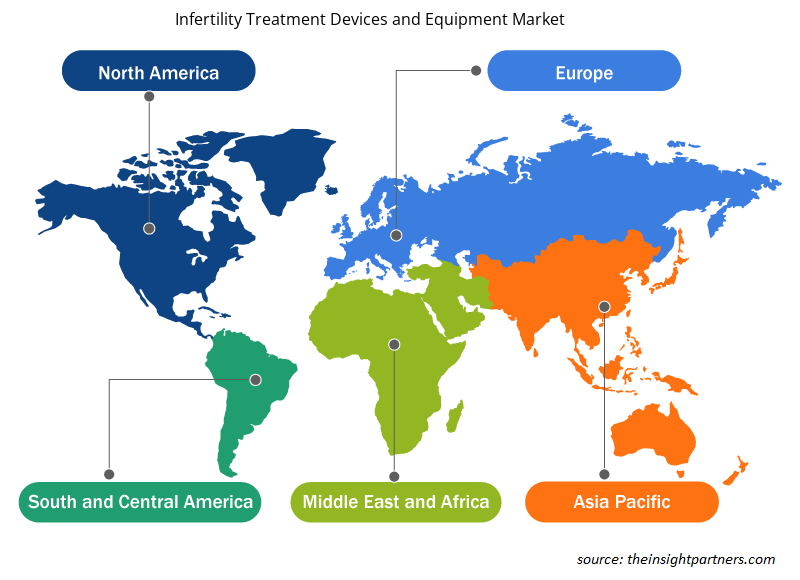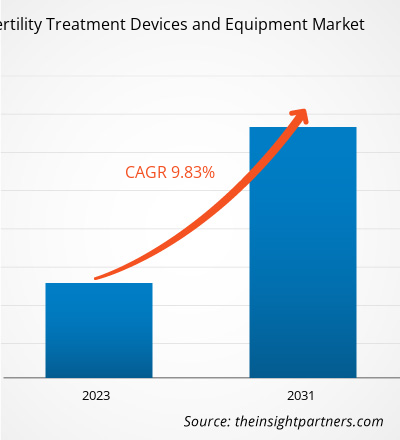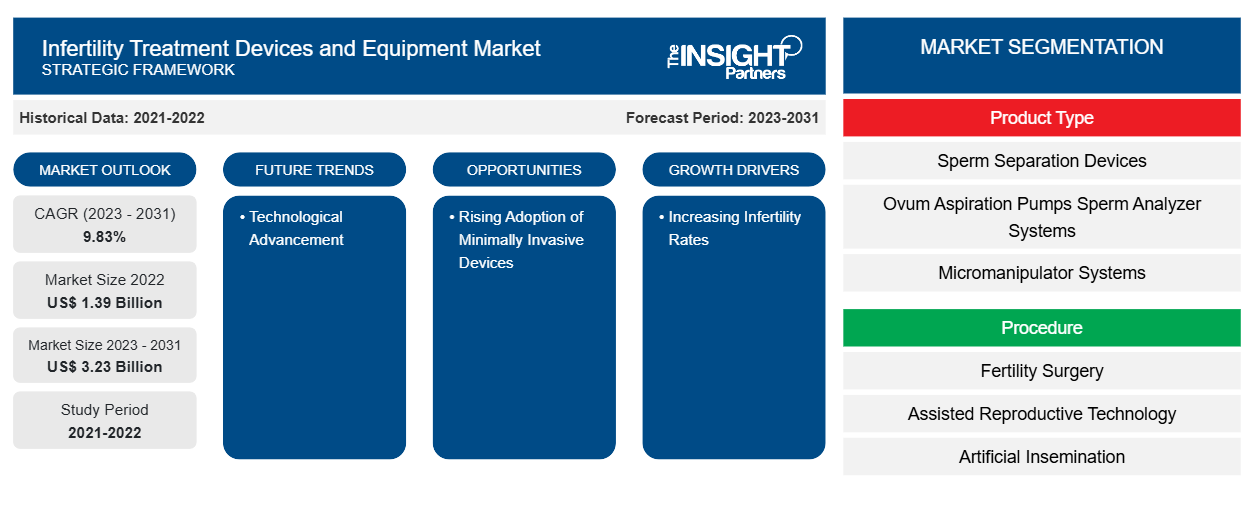Der Markt für Geräte und Ausrüstungen zur Unfruchtbarkeitsbehandlung soll von 1,39 Milliarden US-Dollar im Jahr 2022 auf 3,23 Milliarden US-Dollar im Jahr 2031 anwachsen. Der Markt wird voraussichtlich zwischen 2023 und 2031 eine durchschnittliche jährliche Wachstumsrate von 9,83 % verzeichnen. Die Entwicklung neuartiger Unfruchtbarkeitsbehandlungen wie die intrazytoplasmatische Spermieninjektion dürfte weiterhin ein wichtiger Markttrend für Geräte und Ausrüstungen zur Unfruchtbarkeitsbehandlung bleiben.
Marktanalyse für Geräte und Ausrüstung zur Unfruchtbarkeitsbehandlung
Unfruchtbarkeit ist die Unfähigkeit, nach einem Jahr ungeschützten Geschlechtsverkehrs schwanger zu werden. Die Weltgesundheitsorganisation (WHO) hat sie als Problem der öffentlichen Gesundheit anerkannt. Der globale Markt für Geräte und Ausrüstung zur Behandlung von Unfruchtbarkeit verzeichnet aufgrund verschiedener Faktoren ein erhebliches Wachstum, darunter die sinkende globale Geburtenrate, die höhere Erfolgsrate moderner Reproduktionstechnologien und die wachsende Unterstützung durch die Regierung und andere Gesundheitsorganisationen. Diese Faktoren dürften die Entwicklung neuer Behandlungen zur Verbesserung der Fruchtbarkeit begünstigen.
Marktübersicht für Geräte und Ausrüstung zur Unfruchtbarkeitsbehandlung
Laut WHO leiden weltweit fast 17,5 % der Erwachsenen an Unfruchtbarkeit. Die Lebenszeitprävalenz dieser Erkrankung beträgt in Ländern mit hohem Einkommen 17,8 % und in Ländern mit niedrigem und mittlerem Einkommen 16,5 %. Steigende Fälle von Unfruchtbarkeit führen zu einem Anstieg der Zahl der Patienten, die eine Unfruchtbarkeitsbehandlung suchen. Dies unterstreicht den Bedarf an erschwinglicher, qualitativ hochwertiger Fruchtbarkeitsversorgung, was zur Expansion des Marktes für Geräte und Ausrüstung zur Unfruchtbarkeitsbehandlung beiträgt.
Passen Sie diesen Bericht Ihren Anforderungen an
Sie erhalten kostenlos individuelle Anpassungen an jedem Bericht, einschließlich Teilen dieses Berichts oder einer Analyse auf Länderebene, eines Excel-Datenpakets sowie tolle Angebote und Rabatte für Start-ups und Universitäten.
-
Holen Sie sich die wichtigsten Markttrends aus diesem Bericht.Dieses KOSTENLOSE Beispiel umfasst eine Datenanalyse von Markttrends bis hin zu Schätzungen und Prognosen.
Markttreiber und Chancen für Geräte und Ausrüstung zur Unfruchtbarkeitsbehandlung
Hohe Erfolgsraten moderner Technologien zur Unfruchtbarkeitsbehandlung begünstigen den Markt
Die Fortpflanzungsbehandlungen haben sich deutlich weiterentwickelt, wodurch die Möglichkeiten und Erfolgsraten von Unfruchtbarkeitsbehandlungen wie der assistierten Reproduktionstechnologie (ART) erweitert wurden. Laut einem im Oktober 2022 in Cureus veröffentlichten Artikel wird erwartet, dass IVF in den kommenden Jahren in vielen Regionen der Welt weit verbreitet sein wird und zur Geburt von bis zu 10 % aller Kinder führen wird. Die Erfolgsraten der In-vitro-Reifung (IVM) sind aufgrund des technologischen Fortschritts, der Verbesserung der erforderlichen Werkzeuge und der gesammelten Erfahrung und Ausbildung derjenigen, die den Eingriff durchführen, auf bis zu 56 % gestiegen. Darüber hinaus sind Methoden zur Fruchtbarkeitswahrnehmung wie Apps zur Eisprungverfolgung zugänglicher und zuverlässiger geworden und ermöglichen fundierte Entscheidungen zur Familienplanung
Minimalinvasive Geräte – eine Chance in der Unfruchtbarkeitsbehandlung
Verschiedene Anomalien und Erkrankungen, darunter Uterusmyome, Müller-Anomalien, Eierstockzysten und Endometriose, können die Wahrscheinlichkeit einer Schwangerschaft verringern. Diese Probleme können auch unangenehme Nebenwirkungen wie chronische Beckenschmerzen und starke Blutungen verursachen. In solchen Fällen kann ein chirurgischer Eingriff die wirksamste Behandlung dieser Symptome sein. Der Einsatz minimalinvasiver Techniken wie Laparoskopie und Hysteroskopie kann die zugrunde liegende Ursache der Unfruchtbarkeit behandeln und dabei Schmerzen, Genesungszeit, Infektionsrisiko und Blutverlust verringern. Bei den Verfahren werden kleine Einschnitte und hochauflösende Kameras verwendet, die den Operationsbereich auf einen Monitor projizieren, anstatt großer, offener Einschnitte, wie bei herkömmlichen Operationen.
Marktbericht zu Geräten und Ausrüstungen zur Unfruchtbarkeitsbehandlung – Segmentierungsanalyse
Wichtige Segmente, die zur Ableitung der Marktanalyse für Geräte und Ausrüstung zur Unfruchtbarkeitsbehandlung beitragen, sind Produkttyp, Verfahren und Endbenutzer.
- Basierend auf dem Produkttyp ist der Markt für Geräte und Ausrüstung zur Unfruchtbarkeitsbehandlung in Spermienseparationsgeräte, Eizellenaspirationspumpen, Spermienanalysesysteme, Mikromanipulatorsysteme, Inkubatoren und andere unterteilt. Das Segment der Eizellenaspirationspumpen hatte im Jahr 2023 den größten Marktanteil.
- Nach Verfahren ist der Markt in assistierte Reproduktionstechnologie, Fruchtbarkeitschirurgie und künstliche Befruchtung unterteilt. Das Segment der künstlichen Befruchtung hatte im Jahr 2023 den größten Marktanteil. Darüber hinaus wird erwartet, dass das Segment der assistierten Reproduktionstechnologie von 2023 bis 2031 die höchste durchschnittliche jährliche Wachstumsrate verzeichnet.
- In Bezug auf den Endverbraucher ist der Markt in Fruchtbarkeitskliniken, Krankenhäuser und andere Gesundheitseinrichtungen sowie klinische Forschungsinstitute segmentiert. Das Segment der Fruchtbarkeitskliniken dominierte den Markt im Jahr 2023.
Geräte und Ausrüstungen zur Behandlung von Unfruchtbarkeit Marktanteilsanalyse nach Geografie
Der geografische Umfang des Marktberichts zu Geräten und Ausrüstungen zur Unfruchtbarkeitsbehandlung ist hauptsächlich in fünf Regionen unterteilt: Nordamerika, Asien-Pazifik, Europa, Naher Osten und Afrika sowie Süd- und Mittelamerika.
Nordamerika dominiert den Markt für Geräte und Ausrüstung zur Unfruchtbarkeitsbehandlung. Nach Angaben des US-Gesundheitsministeriums wurden im Jahr 2021 etwa 2,3 % der in den USA geborenen Säuglinge mithilfe von ART gezeugt. In 453 Kliniken wurden 413.776 Zyklen durchgeführt, was zu 112.088 Schwangerschaften führte. Die zunehmende Zahl von AR-Verfahren wie IVF, steigende Unfruchtbarkeitsraten bei Männern und die Präsenz globaler Marktteilnehmer sind Faktoren, die zur Dominanz des nordamerikanischen Marktes für Geräte und Ausrüstung zur Unfruchtbarkeitsbehandlung beitragen. Der asiatisch-pazifische Raum wird in den kommenden Jahren voraussichtlich mit der höchsten durchschnittlichen jährlichen Wachstumsrate wachsen.
Regionale Einblicke in den Markt für Geräte und Ausrüstung zur Unfruchtbarkeitsbehandlung
Die regionalen Trends und Faktoren, die den Markt für Geräte und Ausrüstungen zur Unfruchtbarkeitsbehandlung während des Prognosezeitraums beeinflussen, wurden von den Analysten von Insight Partners ausführlich erläutert. In diesem Abschnitt werden auch die Marktsegmente und die Geografie von Geräten und Ausrüstungen zur Unfruchtbarkeitsbehandlung in Nordamerika, Europa, im asiatisch-pazifischen Raum, im Nahen Osten und Afrika sowie in Süd- und Mittelamerika erörtert.

- Erhalten Sie regionale Daten zum Markt für Geräte und Ausrüstungen zur Unfruchtbarkeitsbehandlung
Umfang des Marktberichts über Geräte und Ausrüstung zur Unfruchtbarkeitsbehandlung
| Berichtsattribut | Details |
|---|---|
| Marktgröße im Jahr 2022 | 1,39 Milliarden US-Dollar |
| Marktgröße bis 2031 | 3,23 Milliarden US-Dollar |
| Globale CAGR (2023 - 2031) | 9,83 % |
| Historische Daten | 2021-2022 |
| Prognosezeitraum | 2023–2031 |
| Abgedeckte Segmente |
Nach Produkttyp
|
| Abgedeckte Regionen und Länder |
Nordamerika
|
| Marktführer und wichtige Unternehmensprofile |
|
Dichte der Marktteilnehmer für Geräte und Ausrüstung zur Unfruchtbarkeitsbehandlung: Die Auswirkungen auf die Geschäftsdynamik verstehen
Der Markt für Geräte und Ausrüstung zur Unfruchtbarkeitsbehandlung wächst rasant. Dies wird durch die steigende Nachfrage der Endnutzer aufgrund von Faktoren wie sich entwickelnden Verbraucherpräferenzen, technologischen Fortschritten und einem größeren Bewusstsein für die Vorteile des Produkts vorangetrieben. Mit der steigenden Nachfrage erweitern Unternehmen ihr Angebot, entwickeln Innovationen, um die Bedürfnisse der Verbraucher zu erfüllen, und nutzen neue Trends, was das Marktwachstum weiter ankurbelt.
Die Marktteilnehmerdichte bezieht sich auf die Verteilung der Firmen oder Unternehmen, die in einem bestimmten Markt oder einer bestimmten Branche tätig sind. Sie gibt an, wie viele Wettbewerber (Marktteilnehmer) in einem bestimmten Marktraum im Verhältnis zu seiner Größe oder seinem gesamten Marktwert präsent sind.
Die wichtigsten Unternehmen auf dem Markt für Geräte und Ausrüstung zur Unfruchtbarkeitsbehandlung sind:
- Thermo Fisher Scientific
- Kochgruppe
- Vitrolife
- IVFtech APS
- Hamilton Thorne Ltd.
- Esco Micro Pte Ltd
Haftungsausschluss : Die oben aufgeführten Unternehmen sind nicht in einer bestimmten Reihenfolge aufgeführt.

- Überblick über die wichtigsten Akteure auf dem Markt für Geräte und Ausrüstungen zur Unfruchtbarkeitsbehandlung
Marktnachrichten und aktuelle Entwicklungen zu Geräten und Ausrüstungen zur Unfruchtbarkeitsbehandlung
Der Markt für Geräte und Ausrüstung zur Unfruchtbarkeitsbehandlung wird durch die Erhebung qualitativer und quantitativer Daten nach Primär- und Sekundärforschung bewertet, die wichtige Unternehmensveröffentlichungen, Verbandsdaten und Datenbanken umfasst. Im Folgenden finden Sie eine Liste der Entwicklungen auf dem Markt für Geräte und Ausrüstung zur Unfruchtbarkeitsbehandlung:
- Trajan Scientific and Medical lieferte CE-IVD-registrierte Mitra-Geräte an Fertilly, ein deutsches Start-up. Fertilly brachte Europas erste Fruchtbarkeitstestkits für zu Hause auf den Markt, die Mikroproben von getrocknetem Blut mit VAMS-Technologie verwenden. Die Mitra-Mikroprobengeräte ermöglichen eine schnelle und einfache Entnahme von Blutproben durch Fingerstiche, die dann zur Analyse als getrocknetes Blut an ein Labor geschickt werden können. (Quelle: Trajan Scientific Australia Pty Ltd, Pressemitteilung, 2023)
- Merck Specialties Pvt ltd, das Gesundheitsunternehmen von Merck in Indien, hat den Pergoveris Pen für eine fortschrittliche Unfruchtbarkeitsbehandlung in Indien auf den Markt gebracht. Diese Markteinführung unterstreicht das Ziel des Unternehmens, ungedeckte medizinische Bedürfnisse zu erfüllen, indem es eine verbesserte, praktische und gebrauchsfertige Kombinationsbehandlungsoption für Frauen mit schwerem Mangel an follikelstimulierendem Hormon (FSH) und luteinisierendem Hormon (LH) anbietet. (Quelle: Merck Specialties Pvt ltd, Pressemitteilung, 2021)
Marktbericht zu Geräten und Ausrüstungen zur Unfruchtbarkeitsbehandlung – Umfang und Ergebnisse
Der Bericht „Marktgröße und Prognose für Geräte und Ausrüstung zur Unfruchtbarkeitsbehandlung (2021–2031)“ bietet eine detaillierte Analyse des Marktes, die die folgenden Bereiche abdeckt:
- Marktgröße und Prognose auf globaler, regionaler und Länderebene für alle wichtigen Marktsegmente, die im Rahmen des Projekts abgedeckt sind
- Marktdynamik wie Treiber, Beschränkungen und wichtige Chancen
- Wichtige Zukunftstrends
- Detaillierte PEST/Porters Five Forces- und SWOT-Analyse
- Globale und regionale Marktanalyse mit wichtigen Markttrends, wichtigen Akteuren, Vorschriften und aktuellen Marktentwicklungen
- Branchenlandschaft und Wettbewerbsanalyse, einschließlich Marktkonzentration, Heatmap-Analyse, prominenten Akteuren und aktuellen Entwicklungen
- Detaillierte Firmenprofile
- Historische Analyse (2 Jahre), Basisjahr, Prognose (7 Jahre) mit CAGR
- PEST- und SWOT-Analyse
- Marktgröße Wert/Volumen – Global, Regional, Land
- Branchen- und Wettbewerbslandschaft
- Excel-Datensatz
Aktuelle Berichte
Erfahrungsberichte
Grund zum Kauf
- Fundierte Entscheidungsfindung
- Marktdynamik verstehen
- Wettbewerbsanalyse
- Kundeneinblicke
- Marktprognosen
- Risikominimierung
- Strategische Planung
- Investitionsbegründung
- Identifizierung neuer Märkte
- Verbesserung von Marketingstrategien
- Steigerung der Betriebseffizienz
- Anpassung an regulatorische Trends























 Kostenlose Probe anfordern für - Markt für Geräte und Ausrüstung zur Unfruchtbarkeitsbehandlung
Kostenlose Probe anfordern für - Markt für Geräte und Ausrüstung zur Unfruchtbarkeitsbehandlung